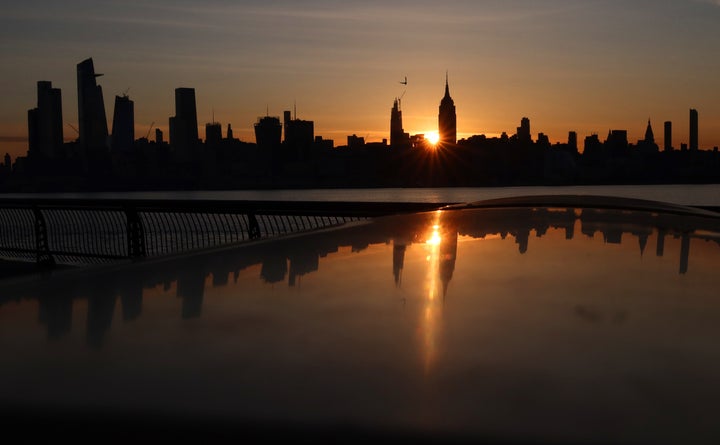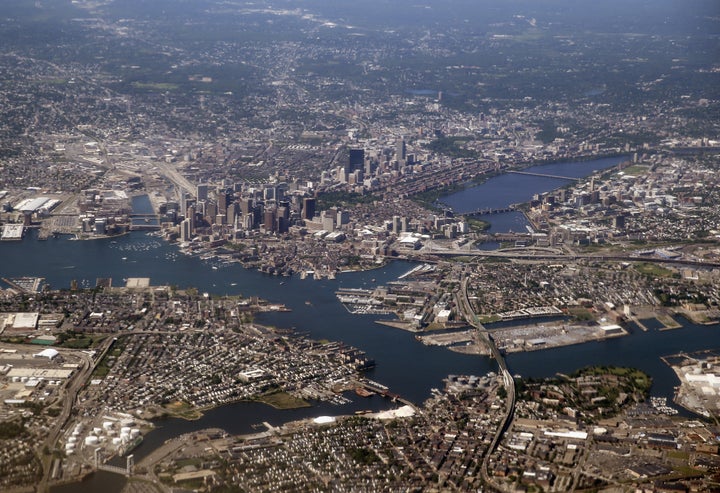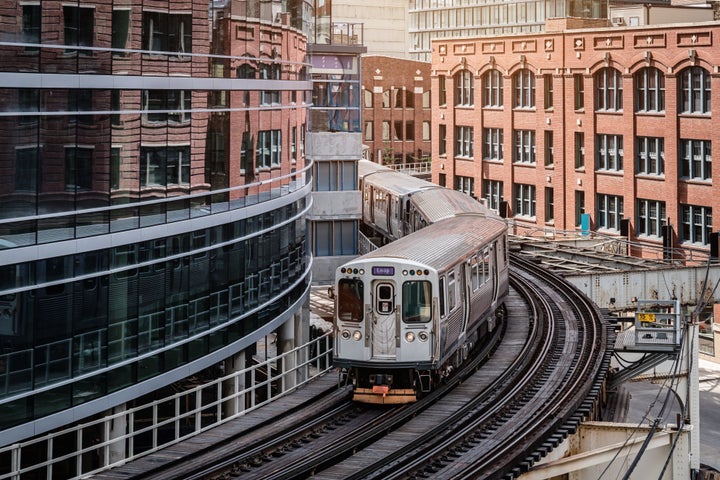The American city has always been a symbol — of prosperity and opportunity, of culture and creativity, of segregation, gentrification, having and having not. Now, suffused with fear of a mortal danger we can’t see and don’t fully understand, our shining cities on a hill flash not a beacon but a warning light: danger, do not enter. Those who can afford to are getting out; some are vowing never to return.
As we crest the curve of the coronavirus pandemic (the first curve, anyway), and prepare to wade into the new normal, it’s our urban hubs that stand to change the most. What might our cities look like in a post-COVID reality? To explore the question, I talked to Binyamin Appelbaum, lead business and economics writer on the New York Times editorial board, which last week published “The Cities We Need,” a sweeping examination and sharp indictment of urbanization over the past half century.
“America’s cities were once engines of growth and opportunity,” the piece proclaims in stark type over an archive photo of the growing Manhattan skyline. “In this crisis, how can we save them?”
Here is our conversation, edited for length and clarity.
Why do you think it is important to write about cities now?
We embarked on this broader project looking at economic inequality in American life. Part of our process was to think about where is that happening, and what is causing it? And a lot of our discussions really centered around geography — around the sense that it’s not just that we have economic inequality, but we literally have spatial separation of people leading different economic lives, and that geographical segregation is a big part of the problem. Cities are the places where we see that most starkly — where the very richest live side by side with the very poorest, in the same city but at the same time in two different worlds.

Is this historically true of cities, or was there a time early on in the American city when this wasn’t the case?
Cities have always attracted the rich and the poor. They have always had stark contrasts between wealth and poverty, really throughout human history. But in America, as recently as 50, 60 years ago, cities had fewer extremes of wealth and poverty, and the rich and the poor were much more thoroughly mixed together.
Yes, there were rich people. Yes, there were poor people. But they often lived in the same neighborhoods and, to a greater extent than is now the case, made use of the same public services, the same — what we describe as — infrastructure of opportunity. The physical divisions were not as stark as they are now, and the inequalities were not as large as they are now, so on both of those dimensions, our cities have really changed. The size of the gap between the richest and the poorest has just gotten a lot bigger. And at the same time, the rich have tended to increasingly congregate together and to exclude the poor from the places where they live.
Something that we have seen over and over in This New World’s coverage of the pandemic is the way it lays bare and exacerbates existing inequalities in society. It sounds like inequality in cities was a topic you were thinking about pre-coronavirus. Did the way the pandemic hit the U.S. change the way you thought about it?
It’s one thing to be aware that rich and poor Americans are living these very different lives, and poor Americans are potentially much more vulnerable to something like a pandemic. And then it happens, and you’re watching as low-income Americans — who still need to go to work, and who are at risk of disease, and who tend to have much higher rates of the health problems that are correlated with higher rates of fatalities from the coronavirus — you’re watching them die, basically. You’re watching the poor die and the rich in their country homes, and it added a sense of urgency to the issues that already seemed important but now seem even more so.
I want to talk about density. The pandemic is only crystallizing the perception of hotbeds like New York City as close and dirty and dingy, and now havens for disease. But I think density gets a bad rap. Yes, urban pollution is a serious problem. But suburban sprawl is ruinous for the environment. And now we’re watching families, fearing the virus, flee to the country. What do we do if there’s an exodus of (mostly affluent) families from cities, moving out of apartments and into energy-inefficient, single-family homes on a couple of acres that infringe on natural habitats?
Cities are hard, we should start by saying that. The economist Ed Glaeser has observed that one reason people in New York tend to be proponents of more government than people in Montana is that they need the government more. When people are living together in close proximity, it’s just more complicated. There’s a greater need for public services, public infrastructure. It is harder to run a city.
But cities are also worth it. Pollution is more of a challenge in an urban environment, but in the aggregate, the level of pollution that we all produce when we live together in density is much lower than it would be if we lived all spread out in the suburbs. So, it is worth it to run cities well.
“Cities are hard ... But cities are also worth it.”
- Binyamin Appelbaum
And we have examples of cities that are being run well. Hong Kong, to take a notable example, has had very little instance of the coronavirus, because they are effectively administering that city. It is denser than New York, but they are doing a good job of running it, and as a result, they’re fine, and we’re not. Not because we’re dense, but because we are not managing density. We are not doing a good job of running our cities.
One part of the reality in America right now is not just that the poor are isolated, but that they are trapped in the places that they’re from. The very idea of picking up and going to the countryside, or moving to a different place, is only available to people who have that flexibility and that freedom — almost by definition, they have wealth in order to be able to do that. And so what we’re really talking about [is]: The poor will be in the cities; the question is, will others be there too? Or are we going to exacerbate the types of inequality that we’ve been talking about? We need to improve the functioning of our cities in order to preserve them, and in order to realize all the benefits of urban life.

I’m thinking about these affluent families leaving. If they go for good, they’re going to be taking their tax and philanthropic dollars with them. How much does that hurt the cities that they leave?
If we see that kind of mass exodus, it would be very painful. We have a lot of precedent for it: Rich people have been moving to the suburbs for a very long time.
I grew up outside of Boston. Most residents of the Boston area live in the suburbs that are clustered around Boston itself. And those suburbs have intentionally resisted, over time, incorporation into the city of Boston, because the wealthier residents of those towns would rather keep their money to themselves. This is a very long-running problem.
One of the fundamental challenges of municipal government in the United States is that the rich would rather live in enclaves and keep their money to themselves and restrict the poor to areas where they’re someone else’s problem. And that’s really bad for cities. It’s really bad for cities if they enter into a cycle where their inability to provide services causes people with choices to leave and that makes it in turn even harder to provide services.
Let’s say a bunch of people do leave New York. Could it actually make the city more affordable?
Predicting the future is inherently fraught. It is certainly the case that, historically, we have been through cycles in which cities have become less attractive to affluent residents and that has opened up opportunities for other people to occupy those spaces. It is undoubtedly the case that if fewer people want to live in cities, the cost of living in a city will go down, and that has some benefits, potentially. These are complicated dynamics. It’s not like everything is bad, it’s not like everything is good. There can be silver linings in clouds, and at least potentially that could be one.
Office leasing in New York is down about 50%, and as companies get more used to remote work and workers start demanding it, office space is only going to continue on a downward trend. What does that do to a city?
It’s good to be sort of skeptical about the degree to which we’re going to see changes as a consequence of this pandemic. Because the way the world works is pretty sticky — it takes a lot to change, and change tends to come slowly. It is undoubtedly the case that on various dimensions we are seeing a shift away from central cities. That is happening with office space already, and it seems perfectly plausible that we’ll see more of it going forward. I would differentiate, however, between that trend and the demise of New York or other urban centers.
There have been, for decades now, predictions that cities would become less important as commercial centers, that prosperity would be spread more evenly across the country because people would be able to move to areas with a lower cost of living and a higher quality of life. They said this about the telegraph, they said it about the telephone, they said it about the computer and the internet. It’s a recurring refrain, and the data says that over that same period the opposite thing has happened. We have only placed a greater importance on clustering together in a relative handful of urban centers that are more economically important than they have ever been before. And so the idea that this finally will break that pattern seems implausible to me on its face.
Even if it were the case that, economically, we put 5% less importance on midtown Manhattan than we did before the pandemic, that would still leave midtown Manhattan’s economic importance as an office center at a higher level than at almost any other moment in American history.

Let’s talk about public transportation. Why is it important? And what happens to cities if public transportation infrastructure gets even worse than it has been?
I worry about transit much more than I worry about downtown office markets. Public transit is part of what we described in our articles as an infrastructure of opportunity. It is an egalitarian system that everyone can use. It makes it possible to travel cheaply and quickly through urban centers. And that’s really important. It’s important in the same way that public schools are important — it levels the playing field. It means that everyone can get across Manhattan at the same speed, irrespective of how much money they have, for the same low fare. And that matters a lot.
Part of what makes cities great and engines of opportunity is that they have this egalitarian infrastructure. That infrastructure is crumbling and has been crumbling for some time, and it is very easy to imagine the pandemic exacerbating that — both by reducing, at least in the near term, the number of people who want to make use of those services, and by further straining the economic capacity of cities to fund necessary repairs in those services.
I think the near-term outlook for public transportation is pretty grim. And the problem is that that builds on itself: If you’re not maintaining now, then it only becomes more expensive to deal with a problem that builds up over time. I’m not sure what to do about it. But I think the concern is very real.
What else do you worry about right now, in our current situation and looking out into the post-COVID reality?
We just had the longest period of uninterrupted growth in American history, and we completely squandered it. We did almost nothing to address the problems that plagued our society, to strengthen the foundation of our economy, or our society, or our democracy. To the contrary, we exacerbated many of those problems. We made things worse, even though we had the opportunity to make things better. And now we find ourselves again in an hour of crisis, and those problems are only greater and growing with time, and it’s now going to be even harder to grapple with them.
“We threw away the last decade and are now faced with even bigger problems in an even more challenging environment.”
- Binyamin Appelbaum
We find ourselves needing more urgently than ever to address inequality, to address under-investment in the infrastructure of our society, to rectify the long-term pattern of disinvestment in public education and in public transportation, in research and development — all of these things that we failed to do when times were good are even more pressing now that times are bad, but even harder to deal with as a consequence. It just feels tragic to me that we threw away the last decade and are now faced with even bigger problems in an even more challenging environment.
You mentioned silver linings earlier. Is there something that you find hopeful, that you’re hanging on to?
Here’s the silver lining that I hang on to: Crisis can be clarifying. I think there’s an opportunity to take stock of what is important about cities. In this hour when cities are not working, when so much of urban life has been suspended, when the real frailties in our system have been exposed, there’s also an opportunity to take stock of what we’ve lost and to say, basically, what is it that we value about cities and how do we get that back again? What matters about cities is that they are places where everyone can come and, together, interact, exchange ideas, pursue opportunities, create new things. There’s just no better place to do that than in a city.
For more content and to be part of the “This New World” community, follow our Facebook page.
HuffPost’s “This New World” series is funded by Partners for a New Economy and the Kendeda Fund. All content is editorially independent, with no influence or input from the foundations. If you have an idea or tip for the editorial series, send an email to thisnewworld@huffpost.com.
- Stay up to date with our live blog as we cover the COVID-19 pandemic
- Seven essential pieces of relationship advice for couples in quarantine
- What you need to know about face masks right now
- How to tell if you need to start doing online therapy
- Lost your job due to coronavirus? Here’s what you need to know.
- Parenting during the coronavirus crisis?
- The HuffPost guide to working from home
- What coronavirus questions are on your mind right now? We want to help you find answers.
- Everyone deserves accurate information about COVID-19. Support journalism without a paywall — and keep it free for everyone — by becoming a HuffPost member today.
